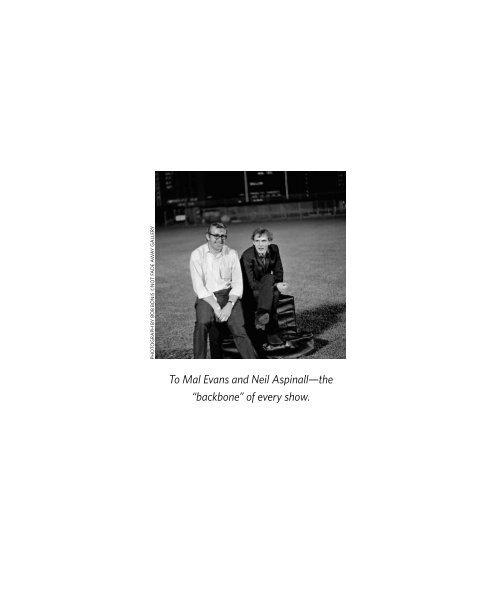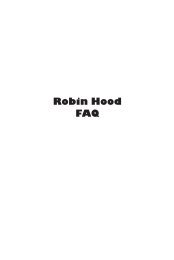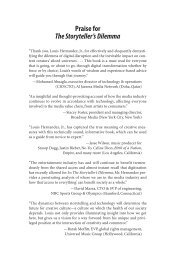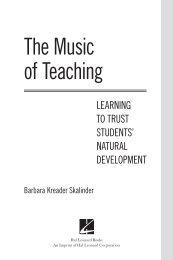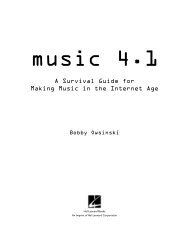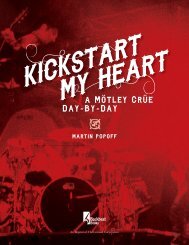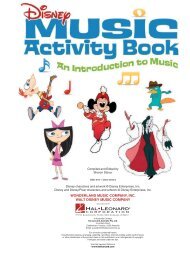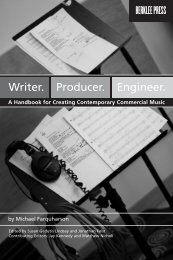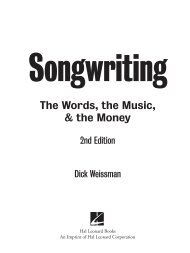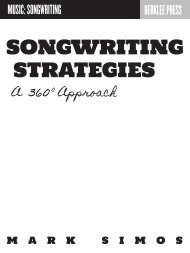You also want an ePaper? Increase the reach of your titles
YUMPU automatically turns print PDFs into web optimized ePapers that Google loves.
Photograph by Bob Bonis ©Not Fade Away Gallery<br />
To Mal Evans and Neil Aspinall—<strong>the</strong><br />
“backbone” <strong>of</strong> every show.
SOME FUN<br />
TONIGHT!<br />
<strong>The</strong> <strong>Backstage</strong> <strong>Story</strong> <strong>of</strong> <strong>How</strong> <strong>the</strong> <strong>Beatles</strong> <strong>Rocked</strong><br />
<strong>America</strong>: <strong>The</strong> <strong>Historic</strong> <strong>Tours</strong> <strong>of</strong> <strong>1964</strong>–<strong>1966</strong><br />
<strong>Volume</strong> 2: <strong>1965</strong>–<strong>1966</strong><br />
Chuck Gunderson<br />
Edited by Mark Naboshek<br />
F O R E W O R D B Y B A R R Y T A S H I A N<br />
I N T R O D U C T I O N B Y L A R R Y K A N E<br />
An Imprint <strong>of</strong> Hal Leonard Corporation
ForEwOrd by Barry Tashian 6<br />
Introduction by Larry Kane 8<br />
Author’s Note 10<br />
Tour Overview and supporting acts 11<br />
August 15 New York 26<br />
August 17 Toronto 42<br />
August 18 Atlanta 52<br />
August 19 Houston 62<br />
August 20 Chicago 70<br />
August 21 Minneapolis 82<br />
August 22 Portland 94<br />
August 28 San Diego 106<br />
August 29-30 Los Angeles 118<br />
August 31 San Francisco 132
Tour Overview and supporting acts 155<br />
August 12 CHICAGO 168<br />
August 13 Detroit 178<br />
August 14 Cleveland 188<br />
August 15 Washington D.C. 194<br />
August 16 Philadelphia 200<br />
August 17 Toronto 208<br />
August 18 Boston 220<br />
August 19 Memphis 232<br />
August 20-21 Cincinnati 244<br />
August 21 St. Louis 256<br />
August 23 New York 264<br />
August 25 Seattle 272<br />
August 28 Los Angeles 282<br />
August 29 San Francisco 294<br />
hotels and venues 310<br />
Acknowledgments 312
Introduction<br />
<strong>The</strong> flashes <strong>of</strong> light were glimmering in <strong>the</strong> evening at Red Rocks Amphi<strong>the</strong>atre<br />
in <strong>the</strong> Rockies outside <strong>of</strong> Denver. <strong>The</strong> screams echoed through <strong>the</strong><br />
rocks and <strong>the</strong> canyons as <strong>the</strong> moon and stars lit up <strong>the</strong> night. On <strong>the</strong> stage,<br />
<strong>the</strong> boys were finishing <strong>the</strong>ir thirty-one minutes <strong>of</strong> vocal electricity. But<br />
what you can never forget in this natural stage <strong>of</strong> drama is <strong>the</strong> eyes <strong>of</strong> <strong>the</strong><br />
boys and girls in <strong>the</strong> audience, especially <strong>the</strong> girls. <strong>The</strong>ir eyes were usually<br />
fixed on one <strong>of</strong> <strong>the</strong> boys, but <strong>the</strong>y never blinked. Tears would roll down <strong>the</strong>ir<br />
faces, tears <strong>of</strong> joy and love. <strong>The</strong> appeal <strong>of</strong> <strong>the</strong> boys, mixing with <strong>the</strong> power<br />
<strong>of</strong> <strong>the</strong> music, transformed <strong>the</strong> people sitting in <strong>the</strong> seats into silent lovers,<br />
<strong>the</strong>ir dreams <strong>of</strong> true connection with <strong>the</strong> Fabs so real; and <strong>the</strong> ones who<br />
were <strong>the</strong>re will never forget <strong>the</strong> stories.<br />
For this reporter, watching <strong>the</strong> crowd night after night at sixty-six<br />
concerts over two years was an unmatched social experience. But <strong>the</strong> real<br />
grit <strong>of</strong> traveling in <strong>the</strong> airplanes and <strong>the</strong> cars, and sleeping doors away from<br />
<strong>the</strong> <strong>Beatles</strong>, was discovering what <strong>the</strong>y were all about.<br />
Mere mortals? Yes. Entertaining? Beyond anything I had ever<br />
witnessed. Intriguing? Absolutely. But <strong>the</strong> way I witnessed <strong>the</strong>m went<br />
beyond <strong>the</strong> silly headlines <strong>of</strong> “mop-tops” and <strong>the</strong> Fab Four. Because along<br />
with just a few o<strong>the</strong>rs in <strong>the</strong> narrow confines <strong>of</strong> a scary airplane, its turboprop<br />
motors keeping me up late at night, I discovered <strong>the</strong> real people<br />
behind <strong>the</strong> mask <strong>of</strong> stereotypes.<br />
<strong>The</strong>re was devilish and unpredictable John, crushing mashed potatoes<br />
and peas into my hair. <strong>The</strong> threat <strong>of</strong> ice cubes down <strong>the</strong> back <strong>of</strong> my shirt<br />
was always present. But <strong>the</strong> most dangerous man on <strong>the</strong> plane was young<br />
Paul, only four months older than me, propping up a pillow, ready for an<br />
intense pillow flight that sometimes ended in a flight <strong>of</strong> fea<strong>the</strong>rs across<br />
<strong>the</strong> aisle. Ringo was quieter, but he was funny as he bounced up and down<br />
<strong>the</strong> aisles. George, who hated flying, looked at me during an emergency<br />
landing in Portland, Oregon, and yelled out, “Larry, remember it’s <strong>Beatles</strong><br />
and children first!”<br />
<strong>The</strong>y were lovely people, famous but not yet reclusive and fed up with<br />
fame. <strong>The</strong>y cared about <strong>the</strong> people surrounding <strong>the</strong>m, checking on <strong>the</strong><br />
supporting acts (who, after all, were <strong>of</strong>ten shouted down by <strong>the</strong> crowds,<br />
8 SOME FUN TONIGHT
who wanted only <strong>the</strong> <strong>Beatles</strong>). <strong>The</strong>y soo<strong>the</strong>d pain. John knew that my<br />
mom had recently died, and he shared with me his agony at <strong>the</strong> death<br />
<strong>of</strong> his mo<strong>the</strong>r. Paul <strong>of</strong>fered his experiences <strong>of</strong> losing a mo<strong>the</strong>r during his<br />
teenage years. In <strong>the</strong> dressing rooms, <strong>the</strong>y made hundreds <strong>of</strong> fan club<br />
members feel good about <strong>the</strong>mselves. <strong>The</strong>y were news and made news,<br />
telling me <strong>the</strong>y would boycott <strong>the</strong> concert in Jacksonville, Florida, if <strong>the</strong><br />
stadium was segregated.<br />
<strong>The</strong> tours had tense security, wild crowds, and lots <strong>of</strong> pushing and<br />
shoving, but <strong>the</strong> boys always made room for o<strong>the</strong>rs. <strong>The</strong>y make our<br />
modern-day self-serving, egocentric stars look like little people with no<br />
brains. And here’s <strong>the</strong> thing. <strong>The</strong>y were living <strong>the</strong> greatest musical history<br />
ever, but <strong>the</strong>y didn’t know how big <strong>the</strong>y were and <strong>the</strong>y had no idea how big<br />
<strong>the</strong>y would become.<br />
And here we are, fifty years later. Chuck Gunderson has gone where no<br />
one else has. He followed up my book, Ticket to Ride, with a new dimension.<br />
With his writing, artifacts, pieces <strong>of</strong> <strong>the</strong> story, superb graphics, and totally<br />
fun reading experience, Chuck has taken you <strong>the</strong>re. “<strong>The</strong>re” is where I was,<br />
lucky enough to see it. Now he relives my experience and <strong>the</strong> experiences<br />
<strong>of</strong> young fans who are now on Medicare. This is no ordinary book. It’s big<br />
and wide and it takes you to where a handful <strong>of</strong> people got to go—traveling<br />
alongside <strong>the</strong> boys, and sharing in <strong>the</strong> joy.<br />
This book is a work <strong>of</strong> art. It’s as close as you can get to being <strong>the</strong>re.<br />
Have some fun tonight with your own backstage pass. As someone who<br />
was <strong>the</strong>re, I can confirm that Chuck has done what no one else has done.<br />
He tells <strong>the</strong> stories <strong>of</strong> three summer tours with an artistic spotlight that<br />
brings you up front and close.<br />
I’m honored that he asked me to help introduce it.<br />
—Larry Kane<br />
is <strong>the</strong> author <strong>of</strong> Ticket to Ride:<br />
Inside <strong>the</strong> <strong>Beatles</strong>’ <strong>1964</strong> and <strong>1965</strong><br />
<strong>Tours</strong> That Changed <strong>the</strong> World,<br />
<strong>the</strong> New York Times best-seller Lennon Revealed,<br />
and When <strong>The</strong>y Were Boys.<br />
<strong>1965</strong>/<strong>1966</strong> 9
August 15, <strong>1965</strong><br />
Shea Stadium<br />
8 p.m.<br />
Shea Stadium<br />
(below) was one <strong>of</strong><br />
<strong>the</strong> largest venues<br />
<strong>the</strong> <strong>Beatles</strong> had<br />
ever played. <strong>The</strong>ir<br />
performance here<br />
set records. Fans<br />
(opposite page)<br />
try anything to<br />
get noticed.<br />
“Sid, do you realize Shea Stadium seats 55,000 people?” “Don’t worry, every seat will be filled.” So<br />
went <strong>the</strong> conversation between stadium manager Jim Thompson and legendary promoter Sid Bernstein.<br />
<strong>The</strong> concert, held on August 15, <strong>1965</strong>, on a warm New York summer evening, did, in fact, fill every seat<br />
<strong>of</strong> <strong>the</strong> cavernous venue and, in <strong>the</strong> process, shattered records for attendance and gross earnings. As<br />
<strong>the</strong> <strong>Beatles</strong> bounded <strong>of</strong>fstage after a spirited version <strong>of</strong> Paul’s “I’m Down,” <strong>the</strong> “Shea Concert” became<br />
<strong>the</strong> stuff <strong>of</strong> legend. <strong>The</strong> event would serve as a template for all future rock extravaganzas, as it showed<br />
promoters and bands alike how to present rock ’n’ roll to <strong>the</strong> masses. <strong>The</strong> concert at Shea became <strong>the</strong><br />
model for Woodstock, Monterey Pop, Altamont, and even worldwide events such as Live Aid.<br />
Planning for <strong>the</strong> Shea Stadium concert actually began in early <strong>1964</strong>. On March 31, after <strong>the</strong> <strong>Beatles</strong>’<br />
wildly popular appearances on <strong>The</strong> Ed Sullivan Show, Norman Weiss <strong>of</strong> General Artists Corporation<br />
(GAC) signed a letter <strong>of</strong> agreement with manager<br />
Brian Epstein to represent <strong>the</strong> <strong>Beatles</strong> in booking<br />
dates for <strong>the</strong> upcoming <strong>1964</strong> North <strong>America</strong>n<br />
tour. GAC, in turn, would receive a 5 percent fee<br />
on <strong>the</strong> gross bookings (which had been negotiated<br />
down from 10 percent by Epstein). It was<br />
understandable that Weiss wanted to represent<br />
<strong>the</strong> <strong>Beatles</strong>, as <strong>the</strong> deal would entail <strong>the</strong> largest<br />
potential grosses <strong>the</strong> GAC VP had seen in his<br />
fifteen years in <strong>the</strong> business.<br />
In early April, Weiss sent Epstein an initial tour<br />
schedule for his review. In <strong>the</strong> schedule, Epstein<br />
was given three choices for <strong>the</strong> September 13<br />
date: play one show at Baltimore’s Civic Center<br />
or play two shows <strong>the</strong> same day. <strong>The</strong> third choice<br />
was a bit shocking, as Weiss had typed in <strong>the</strong><br />
following: “September 13—Shea Stadium. 60,000<br />
seats.” Tickets were to be priced between $2 and<br />
$4. Weiss estimated <strong>the</strong> gross to be $180,000<br />
because one promoter—not Sid Bernstein, but<br />
possibly Ron Delsener, promoter <strong>of</strong> <strong>the</strong> <strong>Beatles</strong>’ <strong>1964</strong> shows in Forest Hills, New York—had <strong>of</strong>fered <strong>the</strong><br />
<strong>Beatles</strong> $50,000 and 50 percent <strong>of</strong> <strong>the</strong> gross. <strong>The</strong> <strong>Beatles</strong> would walk away with at least $90,000 if <strong>the</strong><br />
concert sold out. <strong>The</strong> <strong>of</strong>fer was more than double <strong>the</strong> fee o<strong>the</strong>r promoters were willing to pay.<br />
Shea wasn’t <strong>the</strong> only mega-concert that Weiss presented to Epstein on <strong>the</strong> <strong>1964</strong> tour. He also<br />
floated a couple <strong>of</strong> o<strong>the</strong>r <strong>of</strong>fers from promoters—one for a <strong>Beatles</strong> concert in <strong>the</strong> larger 80,000-seat<br />
Los Angeles Coliseum and ano<strong>the</strong>r that would be played to 200,000 people over three days at New<br />
York City’s Freedomland. <strong>The</strong>se proved to be problematic. Epstein felt that facilities this size would<br />
26 SOME FUN TONIGHT
Corbis
Promoter, Sid<br />
Bernstein, <strong>of</strong>fered<br />
fans <strong>the</strong> souvenir<br />
program well ahead<br />
<strong>of</strong> <strong>the</strong> show, and<br />
kept <strong>the</strong>m updated<br />
with news about <strong>the</strong><br />
upcoming <strong>Beatles</strong><br />
show, along with<br />
o<strong>the</strong>r shows he was<br />
producing.<br />
overexpose his boys, and <strong>the</strong> last thing he wanted was to present <strong>the</strong> group to half-filled venues. For<br />
him, it made better business sense to think conservatively and choose smaller arenas and outdoor<br />
facilities for <strong>the</strong> <strong>1964</strong> tour. As <strong>the</strong> year progressed and Epstein witnessed <strong>the</strong> overwhelming demand<br />
for his group, however, he had a change <strong>of</strong> heart. Maybe <strong>the</strong>re was no better time than <strong>the</strong> present<br />
to blow <strong>the</strong> concert business out <strong>of</strong> <strong>the</strong> water. <strong>The</strong> Shea concert would be a game changer for all<br />
involved—and for all time.<br />
Still, <strong>the</strong> <strong>Beatles</strong>’ <strong>1965</strong> appearance at Shea Stadium wouldn’t have happened without legendary<br />
promoter Sid Bernstein’s unwavering belief in <strong>the</strong> group’s popularity. Born into a traditional Jewish<br />
household in 1918, Bernstein grew up in New York City and served in World War II. When <strong>the</strong> war ended<br />
he looked for work, eventually settling on a career in <strong>the</strong> promotion business. After a successful stint<br />
in <strong>the</strong> resort hotels <strong>of</strong> <strong>the</strong> Catskill Mountains, he began to manage musicians such as Esy Morales. An<br />
appointment with his agent friend Stan Scotland <strong>of</strong> General Artists Corporation resulted in a meeting<br />
with GAC chairman Buddy <strong>How</strong>e, who <strong>of</strong>fered him a job. He began working for <strong>the</strong> powerful New York<br />
talent agency in <strong>the</strong> “One Night” department. With a successful run at GAC under his belt, Bernstein<br />
realized that <strong>the</strong> promotions business was in his blood and left his job to follow his dreams.<br />
Although he was working full-time, Bernstein also managed to continue his education. After hearing<br />
a lecture by Dr. Max Lerner on <strong>the</strong> underpinnings <strong>of</strong> o<strong>the</strong>r world democracies, Bernstein decided to<br />
focus on <strong>the</strong> United Kingdom. <strong>The</strong> promotions man would consume every U.K.-based newspaper he<br />
could find. After reading articles in such newspapers as <strong>the</strong> London Times, <strong>the</strong> Daily Mirror, and <strong>the</strong> New<br />
Musical Express about a pop group that was causing quite a stir, <strong>the</strong> promoter became intrigued.<br />
One day while reading <strong>the</strong> Manchester Guardian, a headline grabbed Bernstein’s attention: “Beatlemania<br />
is about to sweep Great Britain.” Curious, <strong>the</strong> promoter decided to contact Vic Lewis, who was in<br />
charge <strong>of</strong> GAC’s London <strong>of</strong>fice, to see if he knew how to contact <strong>the</strong> group, especially <strong>the</strong>ir manager, Brian<br />
Epstein. Lewis sent a reply to Bernstein, informing him that no one in <strong>America</strong> would be interested in <strong>the</strong><br />
28 SOME FUN TONIGHT
and. <strong>The</strong> <strong>Beatles</strong>, he wrote Bernstein, were just a<br />
local phenomenon. With no airplay in <strong>the</strong> United<br />
States and Epstein booking all <strong>the</strong> concert dates,<br />
Lewis informed Bernstein that <strong>the</strong>y didn’t need<br />
GAC’s services and he should forget about it.<br />
Undaunted, Bernstein remained determined<br />
to make contact with Epstein. Through a chance<br />
meeting in a hotel with Bud Halliwell, an independent<br />
record promotion executive, he got Epstein’s<br />
contact information. Like Vic Lewis, Halliwell<br />
wasn’t sold on <strong>the</strong> <strong>Beatles</strong>. He told Bernstein that<br />
he was having a difficult time selling <strong>the</strong>ir records<br />
and that it was useless to pursue <strong>the</strong>m.<br />
In <strong>the</strong> fall <strong>of</strong> 1963, with number in hand,<br />
Bernstein contacted Epstein to inquire about <strong>the</strong><br />
<strong>Beatles</strong>’ services. Epstein, surprised by a call from<br />
an <strong>America</strong>n promoter, hoped to burst Bernstein’s<br />
bubble by telling him that <strong>the</strong> <strong>Beatles</strong> were<br />
regularly making $2,000 a night for appearances<br />
in <strong>the</strong> U.K. This was <strong>of</strong> no concern to Bernstein,<br />
who had just paid Judy Garland a large sum for<br />
a concert and had regularly paid $10,000 a night<br />
for stars such as Tony Bennett. Bernstein called<br />
Epstein’s bluff and <strong>of</strong>fered <strong>the</strong> manager $6,500<br />
for two shows at New York’s famed Carnegie<br />
Hall, to be held <strong>the</strong> following February. Giddy,<br />
Epstein verbally accepted Bernstein’s <strong>of</strong>fer, but<br />
with one caveat—<strong>the</strong> <strong>Beatles</strong> would need some<br />
major <strong>America</strong>n airplay or <strong>the</strong> contract could not<br />
be formalized. Epstein, as promised, eventually<br />
signed a performance contract for <strong>the</strong> two shows<br />
after “I Want to Hold Your Hand” hit number one<br />
in <strong>the</strong> United States.<br />
History has proven how well it all worked<br />
out. On February 12, <strong>1964</strong>, <strong>the</strong> <strong>Beatles</strong> played<br />
two back-to-back sold-out shows on <strong>the</strong> venue’s<br />
storied stage—all thanks to Bernstein. He also<br />
tried to book <strong>the</strong> group for a February 19 show at<br />
<strong>the</strong> old Madison Square Garden, located on 52nd<br />
Street in New York. <strong>The</strong> <strong>Beatles</strong>’ schedule certainly<br />
would have allowed <strong>the</strong> performance, as <strong>the</strong>y<br />
were not due back in England until February 22.<br />
A press pass (far<br />
left) for <strong>the</strong> show<br />
issued by Bernstein’s<br />
organization. <strong>The</strong><br />
<strong>Beatles</strong> stayed<br />
at <strong>the</strong> Warwick<br />
Hotel (left), still<br />
open today. A rare<br />
handbill (below left),<br />
listed <strong>the</strong> <strong>Beatles</strong>’<br />
show and o<strong>the</strong>r<br />
upcoming acts.<br />
<strong>1965</strong> 29
<strong>The</strong> Library <strong>of</strong> Congress<br />
But <strong>the</strong> lure <strong>of</strong> <strong>the</strong> warm Miami sun was far more<br />
appealing, so Epstein rejected <strong>the</strong> idea. Incredibly,<br />
given his interest in <strong>the</strong> group, Bernstein didn’t<br />
promote a single show on <strong>the</strong> historic <strong>1964</strong> North<br />
<strong>America</strong>n tour. <strong>The</strong> group played several dates in<br />
<strong>the</strong> New York metro and New Jersey areas, but<br />
<strong>the</strong> savvy promoter wasn’t involved. Bernstein<br />
would wait until <strong>1965</strong> and <strong>1966</strong> to secure his place<br />
in pop music by promoting <strong>the</strong> boys’ appearances<br />
at Shea Stadium.<br />
In late October <strong>1964</strong>, after seeing <strong>the</strong> success<br />
<strong>of</strong> <strong>the</strong> recent summer tour, Bernstein hatched an<br />
idea that would transform <strong>the</strong> concert industry<br />
forever. He placed a call to Jim Thompson,<br />
manager at <strong>the</strong> newly opened William A. Shea<br />
Municipal Stadium, and proposed a concert by<br />
<strong>the</strong> <strong>Beatles</strong>. Thompson was agreeable, but only<br />
if five conditions were met. <strong>The</strong> first was finding<br />
a date when <strong>the</strong> Mets baseball team was out<br />
<strong>of</strong> town. Ano<strong>the</strong>r stipulated that a stage would<br />
need to be built and supplied by Bernstein. Also,<br />
insurance would have to be taken out and extra<br />
security provided. Finally, <strong>the</strong> stadium manager<br />
wanted a $50,000 guarantee plus a percentage<br />
<strong>of</strong> <strong>the</strong> gate. Bernstein wisely talked Thompson<br />
down to $25,000 and secured <strong>the</strong> venue. All <strong>the</strong><br />
negotiations involving leasing <strong>the</strong> stadium took<br />
place before Bernstein even contacted Epstein to<br />
see if he was interested!<br />
Soon after, Bernstein placed a call to Epstein<br />
to discuss <strong>the</strong> possibility <strong>of</strong> <strong>the</strong> <strong>Beatles</strong> playing<br />
at Shea at <strong>the</strong> end <strong>of</strong> <strong>the</strong> following summer.<br />
Initially skeptical, Epstein listened to what <strong>the</strong><br />
promoter had to say and became intrigued by<br />
<strong>the</strong> possibilities. Bernstein guaranteed him that<br />
<strong>the</strong> show would be a sellout and even <strong>of</strong>fered <strong>the</strong><br />
manager $10 for every unsold seat. A deal was<br />
struck for Bernstein to pay NEMS Enterprises<br />
an $85,000 guarantee, plus a percentage <strong>of</strong><br />
<strong>the</strong> gate receipts over $167,000. When Epstein<br />
asked for $25,000 up front, Bernstein, knowing<br />
he didn’t have <strong>the</strong> cash on hand, asked for some<br />
time to ga<strong>the</strong>r <strong>the</strong> funds. Epstein agreed. He<br />
told Bernstein that he would be at New York’s<br />
Waldorf Astoria on January 10 to conduct business<br />
and that <strong>the</strong> $25,000 deposit could be<br />
paid at that time. Bernstein told Epstein he’d be<br />
<strong>the</strong>re with <strong>the</strong> money.<br />
<strong>The</strong> negotiations with Bernstein perhaps<br />
inspired Epstein to broaden his horizon and do<br />
as GAC had proposed—select larger venues for<br />
<strong>the</strong> <strong>1965</strong> tour. Bernstein asked Epstein if he could<br />
advertise <strong>the</strong> show to begin generating ticket<br />
An armored<br />
truck was hired<br />
to transport <strong>the</strong><br />
<strong>Beatles</strong> from <strong>the</strong><br />
World’s Fair site<br />
to nearby Shea<br />
Stadium. <strong>The</strong>y had<br />
taken a helicopter<br />
from <strong>the</strong> Wall<br />
Street Heliport<br />
in Manhattan to<br />
Flushing Meadows.<br />
<strong>1965</strong> 31
Chaos backstage, as<br />
John, George, and<br />
Paul fight <strong>the</strong>ir way<br />
through <strong>the</strong> crush <strong>of</strong><br />
people to <strong>the</strong> stage.<br />
©George Orsino (2)<br />
sales, but was informed he could not. <strong>The</strong> ultimate promotions man had to come up with a plan to<br />
generate ticket sales in order to pay Epstein by <strong>the</strong> due date. Using a somewhat unorthodox method,<br />
Bernstein simply told a few kids that <strong>the</strong> <strong>Beatles</strong> were coming back to New York for a summer concert<br />
and shared <strong>the</strong> ticket prices with <strong>the</strong>m. Word <strong>of</strong> an impending <strong>Beatles</strong> visit spread quickly, and soon<br />
post <strong>of</strong>fice box 21 (which Bernstein had set up for <strong>the</strong> event) was inundated with letters stuffed with<br />
money for tickets. Bernstein lugged three duffel bags filled with ticket requests to his home and hired<br />
eight girls to process orders <strong>the</strong>re. <strong>The</strong> girls worked five days a week for a few months and, true to his<br />
word, <strong>the</strong> concert was a sellout. With very little PR effort on his part, he collected $304,000 and was<br />
able to give Epstein <strong>the</strong> full $85,000 during his visit in January.<br />
With <strong>the</strong> concert now secured, Bernstein went to work having a stage built. <strong>The</strong> original $10,000<br />
construction estimate soon swelled to $25,000. <strong>The</strong> $10,000 insurance estimate also escalated, as<br />
Lloyd’s <strong>of</strong> London was <strong>the</strong> only agency <strong>the</strong> promoter could find to insure <strong>the</strong> event.<br />
<strong>The</strong> <strong>Beatles</strong>’ plane landed at New York’s JFK International Airport on Friday, August 13, <strong>1965</strong>, taxiing<br />
to a remote spot far removed from <strong>the</strong> fans assembled to greet <strong>the</strong>m. Both road manager-chauffeur Alf<br />
Bicknell and press <strong>of</strong>ficer Tony Barrow sensed <strong>the</strong> <strong>Beatles</strong>’ frustrations at having to land so far from <strong>the</strong>ir<br />
fans. This had been an ongoing issue during <strong>the</strong> <strong>1964</strong> tour, but at <strong>the</strong> time <strong>of</strong> <strong>the</strong>ir arrival in New York<br />
in <strong>1965</strong>, <strong>America</strong> was in crisis mode as riots erupted in <strong>the</strong> Watts neighborhood <strong>of</strong> Los Angeles. All <strong>the</strong><br />
country needed was ano<strong>the</strong>r riot.<br />
From <strong>the</strong> airport, it was <strong>of</strong>f to midtown Manhattan. <strong>The</strong> group was scheduled to tape an appearance<br />
on <strong>The</strong> Ed Sullivan Show <strong>the</strong> next day (which would air on September 12) and <strong>the</strong>n kick <strong>of</strong>f <strong>the</strong> summer<br />
tour at Shea Stadium on Sunday. Instead <strong>of</strong> staying at <strong>the</strong> Plaza Hotel, management decided to book<br />
<strong>the</strong> group at ano<strong>the</strong>r landmark New York hotel—<strong>the</strong> Warwick. <strong>The</strong> hotel, built by publishing tycoon<br />
William Randolph Hearst, opened in 1926 at a cost <strong>of</strong> $5 million and has hosted many celebrities<br />
32 SOME FUN TONIGHT


